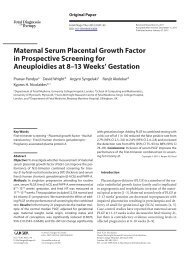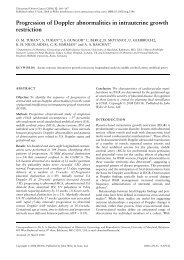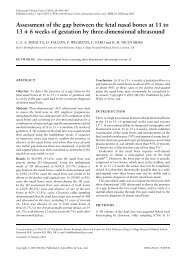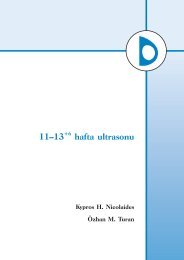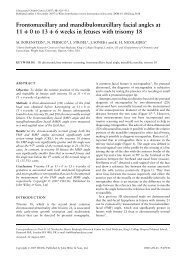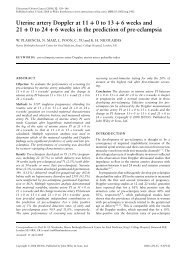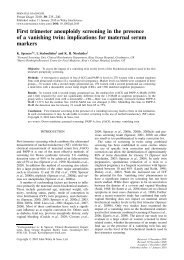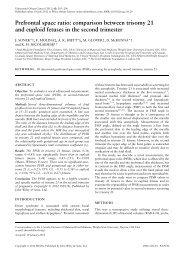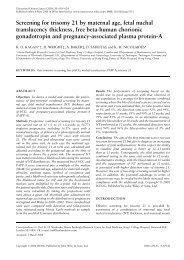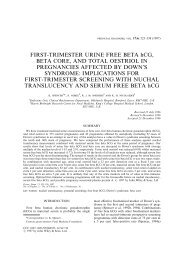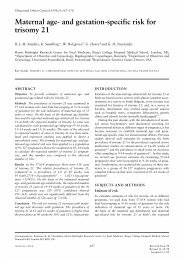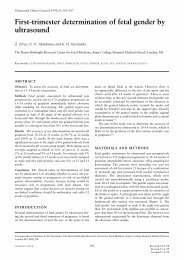Screening for trisomy 21 in twin pregnancies - Fetal Medicine Centre
Screening for trisomy 21 in twin pregnancies - Fetal Medicine Centre
Screening for trisomy 21 in twin pregnancies - Fetal Medicine Centre
Create successful ePaper yourself
Turn your PDF publications into a flip-book with our unique Google optimized e-Paper software.
PRENATAL DIAGNOSIS<br />
Prenat Diagn 2008; 28: 49–52.<br />
Published onl<strong>in</strong>e <strong>in</strong> Wiley InterScience<br />
(www.<strong>in</strong>terscience.wiley.com) DOI: 10.1002/pd.1923<br />
<strong>Screen<strong>in</strong>g</strong> <strong>for</strong> <strong>trisomy</strong> <strong>21</strong> <strong>in</strong> tw<strong>in</strong> <strong>pregnancies</strong> <strong>in</strong> the first<br />
trimester: an update of the impact of chorionicity on<br />
maternal serum markers<br />
Kev<strong>in</strong> Spencer 1,2 *, Karl O. Kagan 2,3 and Kypros H. Nicolaides 2<br />
1 Prenatal <strong>Screen<strong>in</strong>g</strong> Unit, Cl<strong>in</strong>ical Biochemistry Department, K<strong>in</strong>g George Hospital, Goodmayes, IG3 8YB, UK<br />
2 Harris Birthright Research <strong>Centre</strong> <strong>for</strong> <strong>Fetal</strong> Medic<strong>in</strong>e, K<strong>in</strong>gs College Hospital, London<br />
3 Department of Obstetrics and Gynecology, University of Tueb<strong>in</strong>gen, Germany<br />
Objective To exam<strong>in</strong>e the distribution of first-trimester biochemical markers of aneuploidy <strong>in</strong> tw<strong>in</strong><br />
<strong>pregnancies</strong>, and to assess whether there are differences <strong>in</strong> the distributions between monochorionic and<br />
dichorionic tw<strong>in</strong>s.<br />
Methods Maternal serum-free β-hCG and PAPP-A were measured between 11 + 0 and 13 + 6 weeks as part<br />
of a rout<strong>in</strong>e first-trimester screen<strong>in</strong>g program <strong>in</strong> conjunction with fetal nuchal translucency (NT) per<strong>for</strong>med<br />
at two sites. Data from tw<strong>in</strong> <strong>pregnancies</strong> were extracted from the fetal databases along with <strong>in</strong><strong>for</strong>mation on<br />
the chorionicty. The <strong>in</strong>dividual marker concentrations were expressed as weight corrected, ethnicity corrected,<br />
smok<strong>in</strong>g corrected and IVF corrected MoM us<strong>in</strong>g data from s<strong>in</strong>gleton <strong>pregnancies</strong> as the reference. The overall<br />
medians were compared to those <strong>in</strong> s<strong>in</strong>gleton <strong>pregnancies</strong> and between monochorionic and dichorionic tw<strong>in</strong>s.<br />
Results Data was available from 1914 sets of tw<strong>in</strong>s. Of these, 1<strong>21</strong>4 had <strong>in</strong><strong>for</strong>mation with respect to<br />
chorionicity, with 1024 be<strong>in</strong>g dichorionic and 190 be<strong>in</strong>g monochorionic. The overall median weight corrected,<br />
ethnicity corrected, smok<strong>in</strong>g corrected and IVF corrected MoM amongst tw<strong>in</strong> <strong>pregnancies</strong> were 2.023 <strong>for</strong> free<br />
β-hCG (sd log 10 MoM = 0.2611 and 2.1<strong>21</strong> <strong>for</strong> PAPP-A (sd log 10 MoM = 0.2255)—both medians were<br />
significantly greater than the medians <strong>in</strong> s<strong>in</strong>gleton <strong>pregnancies</strong> (1.00 MoM). In the case of monochorionic and<br />
dichorionic tw<strong>in</strong>s the median weight corrected, ethnicity corrected, smok<strong>in</strong>g corrected and IVF corrected, free<br />
β-hCG MoM’s were not significantly different (1.983 v 2.041), however <strong>for</strong> PAPP-A the median weight<br />
corrected, ethnicity corrected, smok<strong>in</strong>g corrected and IVF corrected MoM <strong>in</strong> monochorionic tw<strong>in</strong>s was<br />
significantly lower than <strong>in</strong> dichorionic tw<strong>in</strong>s (1.756 v 2.250) whilst the sd log 10 MoM’s were not significantly<br />
different (0.<strong>21</strong>85 v 0.<strong>21</strong>67).<br />
Conclusion <strong>Screen<strong>in</strong>g</strong> <strong>in</strong> tw<strong>in</strong> <strong>pregnancies</strong> requires adjustment of the calculated MoM to account <strong>for</strong> the<br />
presence of two fetuses. In general, <strong>for</strong> free β-hCG, this should be by divid<strong>in</strong>g the observed corrected MoM by<br />
2.023. For PAPP-A two different factors are required −2.192 <strong>in</strong> dichorionic tw<strong>in</strong>s and 1.788 <strong>in</strong> monochorionic<br />
tw<strong>in</strong>s. Copyright © 2008 John Wiley & Sons, Ltd.<br />
KEY WORDS: PAPP-A; free β-hCG; prenatal screen<strong>in</strong>g; tw<strong>in</strong>s; Down syndrome<br />
INTRODUCTION<br />
First-trimester screen<strong>in</strong>g us<strong>in</strong>g a comb<strong>in</strong>ation of fetal<br />
nuchal translucency (NT) thickness and maternal serumfree<br />
β-hCG and PAPP-A has been shown <strong>in</strong> retrospective<br />
(Spencer et al., 1999) and prospective studies<br />
(Nicolaides et al., 2005) to identify 90% of cases of<br />
<strong>trisomy</strong> <strong>21</strong> with a 5% false positive rate <strong>in</strong> s<strong>in</strong>gleton<br />
<strong>pregnancies</strong>. In tw<strong>in</strong> <strong>pregnancies</strong>, both NT (Sebire et al.,<br />
1996) and maternal serum biochemistry can be comb<strong>in</strong>ed<br />
(Spencer, 2000) to provide detection rates that<br />
would approach those achieved <strong>in</strong> s<strong>in</strong>gleton <strong>pregnancies</strong>.<br />
Whilst these early algorithms were based on relatively<br />
small numbers of cases of tw<strong>in</strong>s, retrospective use has<br />
shown them to be useful <strong>in</strong> identify<strong>in</strong>g <strong>pregnancies</strong> discordant<br />
<strong>for</strong> <strong>trisomy</strong> <strong>21</strong> (Spencer and Nicolaides, 2000,<br />
2003).<br />
*Correspondence to: Kev<strong>in</strong> Spencer, Cl<strong>in</strong>ical Biochemistry<br />
Department, K<strong>in</strong>g George Hospital, Barley Lane, Goodmayes,<br />
Essex IG3 8YB, UK. E-mail: Kev<strong>in</strong>Spencer1@aol.com<br />
An <strong>in</strong>itial study (Spencer, 2001) which looked at the<br />
<strong>in</strong>fluence of chorionicity on biochemical marker levels<br />
concluded that there was no statistically significant<br />
difference between marker levels <strong>in</strong> monochorionic and<br />
dichorionic tw<strong>in</strong>s—despite there be<strong>in</strong>g the suggestion of<br />
lower values of PAPP-A <strong>in</strong> the <strong>for</strong>mer case. Subsequent<br />
small studies have confirmed no difference <strong>in</strong> marker<br />
levels between mono and dichorionic tw<strong>in</strong>s (Gonce<br />
et al., 2005; Wojdemann et al., 2006).<br />
The present study was undertaken to provide more<br />
secure <strong>in</strong><strong>for</strong>mation on the distribution of biochemical<br />
markers <strong>in</strong> tw<strong>in</strong> <strong>pregnancies</strong> and to establish if the<br />
previously observed difference <strong>in</strong> median PAPP-A MoM<br />
<strong>in</strong> monochrorionic tw<strong>in</strong>s is significant <strong>in</strong> a larger series.<br />
MATERIALS AND METHODS<br />
All women booked <strong>for</strong> maternity care at the follow<strong>in</strong>g<br />
UK hospitals were offered screen<strong>in</strong>g <strong>for</strong> <strong>trisomy</strong> <strong>21</strong><br />
by a comb<strong>in</strong>ation of fetal NT and maternal serum-free<br />
Copyright © 2008 John Wiley & Sons, Ltd. Received: 3 October 2007<br />
Revised: 12 November 2007<br />
Accepted: 18 November 2007
50 K. SPENCER ET AL.<br />
β-hCG and PAPP-A at 11 +0 to 13 +6 weeks’ gestation:<br />
Harold Wood Hospital, Rom<strong>for</strong>d (between June 1998<br />
and December 2005), K<strong>in</strong>g George Hospital, Goodmayes<br />
(between July 2001 and December 2005), Kent<br />
and Canterbury Hospital, Canterbury (between July<br />
2002 and December 2005), William Harvey Hospital,<br />
Ash<strong>for</strong>d (between July 2002 and December 2005),<br />
Queen Elizabeth The Queen Mother’s Hospital, Margate<br />
(between July 2002 and December 2005), K<strong>in</strong>g’s<br />
College Hospital, London (between January 1999 and<br />
February 2000) and those attend<strong>in</strong>g The <strong>Fetal</strong> Medic<strong>in</strong>e<br />
<strong>Centre</strong>, London (between July 1999 and June 2005).<br />
Women received an <strong>in</strong><strong>for</strong>mation leaflet about the service<br />
and gave details about their demographic characteristics<br />
and medical history, which were entered <strong>in</strong>to a computer<br />
database (PIA-<strong>Fetal</strong> Database, ViewPo<strong>in</strong>t, Webl<strong>in</strong>g, Germany).<br />
Maternal serum-free β-hCG and PAPP-A were measured<br />
us<strong>in</strong>g the Kryptor analyzer (Brahms AG, Berl<strong>in</strong>,<br />
Germany) as previously described (Spencer et al., 1999)<br />
and an ultrasound exam<strong>in</strong>ation was carried out to measure<br />
fetal NT and crown–rump length (CRL) and to<br />
diagnose any major fetal abnormalities. All scans were<br />
carried out by sonographers who had obta<strong>in</strong>ed The <strong>Fetal</strong><br />
Medic<strong>in</strong>e Foundation Certificate of Competence <strong>in</strong> the<br />
11 +0 to 13 +6 week scan (www.fetalmedic<strong>in</strong>e.com). At<br />
the Harold Wood Hospital, K<strong>in</strong>g George Hospital and the<br />
<strong>Fetal</strong> Medic<strong>in</strong>e <strong>Centre</strong> chorionicity was recorded <strong>in</strong> tw<strong>in</strong><br />
<strong>pregnancies</strong> by the identification of the lambda sign <strong>in</strong><br />
dichorionic tw<strong>in</strong>s (Monteagudo et al., 1994; Sepulveda<br />
et al., 1996, 1997). Patient-specific risks were calculated<br />
by a multivariate approach us<strong>in</strong>g biochemical population<br />
parameters outl<strong>in</strong>ed <strong>in</strong> a previous study (Spencer<br />
et al., 1999), likelihood ratios based on delta NT outl<strong>in</strong>ed<br />
<strong>in</strong> a previous study (Spencer et al., 2003a) and<br />
the gestational age-related risk of <strong>trisomy</strong> <strong>21</strong> at the time<br />
of screen<strong>in</strong>g (Snijders et al., 1999). Data on pregnancy<br />
outcome were obta<strong>in</strong>ed from the cytogenetics laboratories,<br />
the National Chromosomal Anomaly Register, the<br />
patients themselves, their general practitioners or the<br />
maternity units <strong>in</strong> which they delivered.<br />
The measured free β-hCG and PAPP-A were converted<br />
to a multiple of the expected normal median<br />
(MoM) <strong>for</strong> a pregnancy of the same gestational day<br />
us<strong>in</strong>g values established <strong>in</strong> a previous study (Ong et al.,<br />
2000) corrected <strong>for</strong> maternal weight (Spencer et al.,<br />
2000, 2003b), ethnicity (Spencer et al., 2005), smok<strong>in</strong>g<br />
(Spencer et al., 2004) and assisted reproduction (Liao<br />
et al., 2001). Gestational age was calculated from the<br />
CRL of the larger tw<strong>in</strong>.<br />
The fetal database was searched <strong>for</strong> records of liveborn<br />
tw<strong>in</strong> <strong>pregnancies</strong>, which had complete outcome<br />
<strong>in</strong><strong>for</strong>mation, <strong>in</strong>clud<strong>in</strong>g gestational age at delivery (completed<br />
weeks), and pregnancy outcome.<br />
Statistical analysis of corrected PAPP-A and free βhCG<br />
MoM’s <strong>in</strong> all cases of tw<strong>in</strong>s, and <strong>in</strong> cases classified<br />
as monochorionic or dichorionic were per<strong>for</strong>med us<strong>in</strong>g<br />
t-test of unequal variance with the log 10 MoMs and<br />
us<strong>in</strong>g nonparametric Mann-Whitney tests on the untrans<strong>for</strong>med<br />
MoMs us<strong>in</strong>g Analyse-It (Leeds), a statistical<br />
add-<strong>in</strong> <strong>for</strong> Microsoft Excel.<br />
RESULTS<br />
Totally, data from 1914 sets of tw<strong>in</strong>s were available<br />
<strong>for</strong> analysis, and of these, 1024 were dichorionic,<br />
and 190 were monochorionic. This dataset <strong>in</strong>cludes<br />
those previously published (Spencer, 2000; Spencer and<br />
Nicolaides, 2003). Table 1 summarizes the characteristics<br />
of the group. The overall median corrected MoM<br />
<strong>in</strong> the tw<strong>in</strong> dataset was 2.023 (95% confidence Interval<br />
(CI) 1.958–2.085) <strong>for</strong> free β-hCG and 2.1<strong>21</strong> (95%<br />
CI 2.080–2.191) <strong>for</strong> PAPP-A. The standard deviation<br />
of log 10 free β-hCG was 0.2611 and <strong>for</strong> PAPP-A was<br />
0.2255.<br />
When we exam<strong>in</strong>ed the distributions accord<strong>in</strong>g to<br />
chorionicity the median MoM-free β-hCG was not significantly<br />
different between monochorionic (1.983; 95%<br />
CI 1.794–2.195) and dichorionic tw<strong>in</strong>s (2.041; 905% CI<br />
1.932–2.130) when tested us<strong>in</strong>g Mann-Whitney (p =<br />
0.9278). When the log 10 MoMs were exam<strong>in</strong>ed by ttest<br />
aga<strong>in</strong> there was no difference (p = 0.7626) and the<br />
sd’s were 0.3060 and 0.2512 respectively. For PAPP-<br />
A, however, there was a highly significant difference<br />
<strong>in</strong> the distribution between monochorionic (1.756; 95%<br />
CI 1.651–1.868) and dichorionic tw<strong>in</strong>s (2.250; 95% CI<br />
2.152–2.337) when tested us<strong>in</strong>g Mann-Whitney (p <<br />
0.0001). When the log 10 MoMs were exam<strong>in</strong>ed by ttest<br />
aga<strong>in</strong> there was a significant difference (p < 0.0001)<br />
with the sd’s be<strong>in</strong>g 0.<strong>21</strong>67 and 0.<strong>21</strong>85 respectively.<br />
DISCUSSION<br />
This study has confirmed <strong>for</strong> the first time that the<br />
distribution of PAPP-A <strong>in</strong> monochorionic tw<strong>in</strong>s is lower<br />
than that <strong>in</strong> dichorionic tw<strong>in</strong>s and builds upon our earlier<br />
suspicion of such a difference (Spencer, 2001). In our<br />
<strong>for</strong>mer study of 135 dichorionic and 45 monochorionic<br />
tw<strong>in</strong>s we found a lower median MoM PAPP-A <strong>in</strong><br />
the monochorionic tw<strong>in</strong>s (1.66 v 1.89), which did not<br />
reach statistical significance. In another small study<br />
of 150 dichorionic tw<strong>in</strong>s and 31 monochorionic tw<strong>in</strong>s,<br />
Wojdemann et al., 2006 found no difference <strong>in</strong> marker<br />
levels between the two groups, but found an overall<br />
median MoM of 2.14 <strong>for</strong> PAPP-A (log sd 0.248)<br />
and 2.06 <strong>for</strong> free β-hCG (log sd 0.230). Niemimaa<br />
Table 1—Characteristics of the tw<strong>in</strong> population<br />
Median maternal age (years) 32.9<br />
Median gestational age (Weeks) 12.4<br />
Mean crown-rump length (mm) 62.7<br />
Tw<strong>in</strong> 1 62.8<br />
Tw<strong>in</strong> 2 62.6<br />
Afro-Caribbean (%) 3.76<br />
Asian (%) 5.64<br />
Oriental (%) 0.78<br />
Caucasian (%) 84.48<br />
Other (%) 1.10<br />
Not stated (%) 4.23<br />
Smoker (%) 10.29<br />
IVF pregnancy (%) 14.00<br />
Copyright © 2008 John Wiley & Sons, Ltd. Prenat Diagn 2008; 28: 49–52.<br />
DOI: 10.1002/pd
et al. (2002) <strong>in</strong> a study of 54 dichorionic and 13<br />
monochorionic tw<strong>in</strong>s also found no significant difference<br />
<strong>in</strong> biochemical marker levels between the two groups<br />
with an overall median-free β-hCG MoM of 1.85 and<br />
2.36 <strong>for</strong> PAPP-A. Gonce et al. (2005) <strong>in</strong> a study of<br />
100 tw<strong>in</strong> <strong>pregnancies</strong> compriz<strong>in</strong>g 87 dichorionic and<br />
11 monochorionic tw<strong>in</strong>s, found no significant difference<br />
<strong>in</strong> serum markers between the two groups. However,<br />
the overall median-free β-hCG MoM was lower than<br />
observed <strong>in</strong> other series (1.57, log sd 0.2614) whilst<br />
that <strong>for</strong> PAPP-A was similar to others (1.96, log sd<br />
0.2465).<br />
In summariz<strong>in</strong>g the world series of data on tw<strong>in</strong>s<br />
(Spencer, 2005) <strong>in</strong> 825 cases, the median-free β-hCG<br />
was 2.035, and <strong>in</strong> 707 cases the median PAPP-A was<br />
1.826. If the current data are added <strong>in</strong>to this the medianfree<br />
β-hCG <strong>in</strong> 2356 cases become 2.012, and <strong>in</strong> 2238<br />
cases the median PAPP-A was 2.072.<br />
<strong>Screen<strong>in</strong>g</strong> <strong>in</strong> tw<strong>in</strong>s by biochemistry alone is considered<br />
problematical by some (Cuckle, 1998), despite<br />
evidence that second-trimester screen<strong>in</strong>g can clearly dist<strong>in</strong>guish<br />
around 50% of cases discordant <strong>for</strong> <strong>trisomy</strong> <strong>21</strong><br />
(Spencer et al., 1994). In the first trimester, NT clearly<br />
has a much greater role to play <strong>in</strong> be<strong>in</strong>g able to provide<br />
an <strong>in</strong>dividual or fetal risk rather than biochemistry<br />
alone, which provides a pregnancy risk. Whilst NT can<br />
be used successfully to screen <strong>in</strong> tw<strong>in</strong>s with a similar<br />
detection rate and false positive rate to that <strong>in</strong> s<strong>in</strong>gleton<br />
<strong>pregnancies</strong>, the comb<strong>in</strong>ation of both first-trimester NT<br />
and maternal serum biochemistry can improve the overall<br />
detection rate to around 80% (Spencer, 2000) us<strong>in</strong>g<br />
the pseudo-risk approach, and this has been borne out <strong>in</strong><br />
prospective screen<strong>in</strong>g practice (Spencer and Nicolaides,<br />
2003). Other alternative strategies <strong>in</strong>volv<strong>in</strong>g pregnancyspecific<br />
risks have been proposed (Wald et al., 2003)<br />
which use estimated distributions of markers <strong>in</strong> tw<strong>in</strong>s<br />
rather than mak<strong>in</strong>g correction <strong>for</strong> tw<strong>in</strong>s and the calculation<br />
of a s<strong>in</strong>gleton equivalent or pseudo risk. The<br />
problem with this approach is the sparse data available<br />
to determ<strong>in</strong>e the distribution of markers <strong>in</strong> tw<strong>in</strong>s concordant<br />
or discordant <strong>for</strong> <strong>trisomy</strong> <strong>21</strong>. In a meta-analysis of<br />
the world published series Spencer (2005) was only able<br />
to show 6 concordant cases and 23 discordant cases.<br />
The data from this present study will enable more<br />
accurate tw<strong>in</strong> risks to be produced, and <strong>in</strong> <strong>pregnancies</strong><br />
where chorionicity is known, then the use of a specific<br />
monochorionic tw<strong>in</strong> correction factor along with the<br />
use of the average NT measured <strong>in</strong> the two fetuses<br />
or the average fetal risks (Vandecruys et al., 2005) will<br />
improve the accuracy of the <strong>in</strong>dividual patient-specific<br />
risk.<br />
REFERENCES<br />
Cuckle H. 1998. Down syndrome screen<strong>in</strong>g <strong>in</strong> tw<strong>in</strong>s. J Med Screen 5:<br />
3–4.<br />
Gonce A, Borrell A, Fortuny A, et al. 2005. First trimester screen<strong>in</strong>g<br />
<strong>for</strong> <strong>trisomy</strong> <strong>21</strong> <strong>in</strong> tw<strong>in</strong> pregnancy: does the addition of biochemistry<br />
make an improvement? Prenat Diagn 25: 1156–1161.<br />
Liao AW, Heath V, Kametas N, Spencer K, Nicolaides KH. 2001.<br />
First trimester screen<strong>in</strong>g <strong>for</strong> <strong>trisomy</strong> <strong>21</strong> <strong>in</strong> s<strong>in</strong>gleton <strong>pregnancies</strong><br />
achieved by assisted reproduction. Hum Reprod 16: 1501–1504.<br />
TRISOMY <strong>21</strong> SCREENING IN TWIN PREGNANCIES 51<br />
Monteagudo A, Timor-Tritsch I, Sharma S. 1994. Early and simple<br />
determ<strong>in</strong>ation of chorionic and amniotic type <strong>in</strong> multifetal gestations<br />
<strong>in</strong> the first 14 weeks by high frequency transvag<strong>in</strong>al ultrasound. Am<br />
J Obstet Gynecol 170: 824–829.<br />
Nicolaides KH, Spencer K, Avgidou K, Faiola S, Falcon O. 2005.<br />
Mutlitcenter study of first-trimester screen<strong>in</strong>g <strong>for</strong> <strong>trisomy</strong> <strong>21</strong> <strong>in</strong><br />
75,8<strong>21</strong> <strong>pregnancies</strong>: results and estimation of the potential impact<br />
of <strong>in</strong>dividual risk-orientated two stage first trimester screen<strong>in</strong>g.<br />
Ultrasound Obstet Gynaecol 25: 2<strong>21</strong>–226.<br />
Niemimaa M, Suonpaa M, He<strong>in</strong>onen S, Seppala M, Bloigu R,<br />
Ryynanen M. 2002. Maternal serum human chorionic gonadotroph<strong>in</strong><br />
and pregnancy associated plasma prote<strong>in</strong> A <strong>in</strong> tw<strong>in</strong> <strong>pregnancies</strong> <strong>in</strong><br />
the first trimester. Prenat Diagn 22: 183–185.<br />
Ong CYT, Liao AW, Spencer K, Munim S, Nicolaides KH. 2000.<br />
First trimester maternal serum free β human chorionic<br />
gonadotroph<strong>in</strong> and pregnancy associated plasma prote<strong>in</strong> A as<br />
predictors of pregnancy complications. Br J Obstet Gynaecol 107:<br />
1265–1270.<br />
Sebire NJ, Snijders RJM, Hughes K, Sepulveda W, Nicolaides KH.<br />
1996. <strong>Screen<strong>in</strong>g</strong> <strong>for</strong> <strong>trisomy</strong> <strong>21</strong> <strong>in</strong> tw<strong>in</strong> <strong>pregnancies</strong> by maternal<br />
age and fetal nuchal translucency thickness at 10–14 weeks of<br />
gestation. BJOG 103: 999–1003.<br />
Sepulveda W, Sebire NJ, Hughes K, Odibo A, Nicolaides KH. 1996.<br />
The lambda sign at 10–14 weeks of gestation as a predictor of<br />
chorionicity <strong>in</strong> tw<strong>in</strong> <strong>pregnancies</strong>. Ultrasound Obstet Gynecol 7:<br />
4<strong>21</strong>–423.<br />
Sepulveda W, Sebire NJ, Hughes K, Kalogeropoulos A, Nicolaides<br />
KH. 1997. Evolution of the lambda or tw<strong>in</strong>/chorionic peak sign <strong>in</strong><br />
dichorionic tw<strong>in</strong> <strong>pregnancies</strong>. Obstet Gynecol 89: 439–441.<br />
Snijders RJM, Sundberg K, Holzgreve W, Henry G, Nicolaides KH.<br />
1999. Maternal age and gestation specific risk <strong>for</strong> <strong>trisomy</strong> <strong>21</strong>.<br />
Ultrasound Obstet Gynaecol 13: 167–170.<br />
Spencer K. 2000. <strong>Screen<strong>in</strong>g</strong> <strong>for</strong> <strong>trisomy</strong> <strong>21</strong> <strong>in</strong> tw<strong>in</strong> <strong>pregnancies</strong> <strong>in</strong> the<br />
first trimester us<strong>in</strong>g free β-hCG and PAPP-A comb<strong>in</strong>ed with fetal<br />
nuchal translucency thickness. Prenat Diagn 20: 91–95.<br />
Spencer K. 2001. <strong>Screen<strong>in</strong>g</strong> <strong>for</strong> <strong>trisomy</strong> <strong>21</strong> <strong>in</strong> tw<strong>in</strong> <strong>pregnancies</strong> <strong>in</strong><br />
the first trimester: does chorionicity impact on maternal serum free<br />
β-hCG or PAPP-A levels? Prenat Diagn <strong>21</strong>: 715–717.<br />
Spencer K. 2005. Non-<strong>in</strong>vasive screen<strong>in</strong>g tests. In Multiple<br />
Pregnancy, Epidemiology, Gestation & Per<strong>in</strong>atal Outcome,<br />
Blickste<strong>in</strong> I, Keith LG (eds). Taylor & Francis: Ab<strong>in</strong>gdon;<br />
368–384.<br />
Spencer K, Nicolaides KH. 2000. First trimester prenatal diagnosis<br />
of <strong>trisomy</strong> <strong>21</strong> <strong>in</strong> discordant tw<strong>in</strong>s us<strong>in</strong>g fetal nuchal translucency<br />
thickness and maternal serum free β-hCG and PAPP-A. Prenat<br />
Diagn 20: 683–684.<br />
Spencer K, Nicolaides KH. 2003. <strong>Screen<strong>in</strong>g</strong> <strong>for</strong> <strong>trisomy</strong> <strong>21</strong> <strong>in</strong> tw<strong>in</strong>s<br />
us<strong>in</strong>g first trimester ultrasound and maternal serum biochemistry <strong>in</strong><br />
a one stop cl<strong>in</strong>ic: a review of three years experience. BJOG 110:<br />
276–280.<br />
Spencer K, Salonen R, Muller F. 1994. Down’s syndrome screen<strong>in</strong>g<br />
<strong>in</strong> multiple <strong>pregnancies</strong> us<strong>in</strong>g alpha fetoprote<strong>in</strong> and free beta hCG.<br />
Prenat Diagn 14: 537–542.<br />
Spencer K, Ong CYT, Liao AWK, Nicolaides KH. 2000. The<br />
<strong>in</strong>fluence of ethnic orig<strong>in</strong> on first trimester biochemical markers<br />
of chromosomal anomalies <strong>in</strong> the first trimester. Prenat Diagn 20:<br />
491–494.<br />
Spencer K, B<strong>in</strong>dra R, Cachao AM, Nicolaides KH. 2004. The impact<br />
of correct<strong>in</strong>g <strong>for</strong> smok<strong>in</strong>g status when screen<strong>in</strong>g <strong>for</strong> chromosomal<br />
anomalies us<strong>in</strong>g maternal serum biochemistry and fetal nuchal<br />
translucency thickness <strong>in</strong> the first trimester of pregnancy. Prenat<br />
Diagn 24: 169–173.<br />
Spencer K, Souter V, Tul N, Snijders R, Nicolaides KH. 1999. A<br />
screen<strong>in</strong>g program <strong>for</strong> <strong>trisomy</strong> <strong>21</strong> at 10–14 weeks us<strong>in</strong>g fetal<br />
nuchal translucency, maternal serum free β-human chorionic<br />
gonadotrop<strong>in</strong> and pregnancy associated plasma prote<strong>in</strong>-A.<br />
Ultrasound Obstet Gynecol 13: 231–237.<br />
Spencer K, B<strong>in</strong>dra R, Nix ABJ, Heath V, Nicolaides KH. 2003a.<br />
Delta-NT or NT MoM: which is the most appropriate method <strong>for</strong><br />
calculat<strong>in</strong>g accurate patient specific risks <strong>for</strong> <strong>trisomy</strong> <strong>21</strong> <strong>in</strong> the first<br />
trimester? Ultrasound Obstet Gynaecol 22: 142–148.<br />
Spencer K, B<strong>in</strong>dra R, Nicolaides KH. 2003b. Maternal weight<br />
correction of maternal serum PAPP-A and free β-hCG when<br />
screen<strong>in</strong>g <strong>for</strong> <strong>trisomy</strong> <strong>21</strong> <strong>in</strong> the first trimester of pregnancy. Prenat<br />
Diagn 23: 851–855.<br />
Copyright © 2008 John Wiley & Sons, Ltd. Prenat Diagn 2008; 28: 49–52.<br />
DOI: 10.1002/pd
52 K. SPENCER ET AL.<br />
Spencer K, Heath V, El-Sheikhah A, Ong CYT, Nicolaides KH.<br />
2005. Ethnicity and the need <strong>for</strong> correction of biochemical and<br />
ultrasound markers of chromosomal anomalies <strong>in</strong> the first trimester:<br />
a study of Oriental, Asian and Afro-Caribbean populations. Prenat<br />
Diagn 25: 365–369.<br />
Vandecruys H, Faiola S, Auer M, Sebire N, Nicolaides KH. 2005.<br />
<strong>Screen<strong>in</strong>g</strong> <strong>for</strong> <strong>trisomy</strong> <strong>21</strong> <strong>in</strong> monochorionic tw<strong>in</strong>s by measurement<br />
of fetal nuchal translucency thickness. Ultrasound Obstet Gynecol<br />
25: 551–553.<br />
Wald NJ, Rish S, Hackshaw AK. 2003. Comb<strong>in</strong><strong>in</strong>g nuchal translucency<br />
and serum markers <strong>in</strong> prenatal screen<strong>in</strong>g <strong>for</strong> Down syndrome<br />
<strong>in</strong> tw<strong>in</strong> <strong>pregnancies</strong>. Prenat Diagn 23: 588–592.<br />
Wojdemann KR, Larsen SO, Shalmi A-C, Sundberg K, Tabor A,<br />
Christiansen M. 2006. Nuchal translucency measurements are<br />
highly correlated <strong>in</strong> both mono- and dichorionic tw<strong>in</strong> pairs. Prenat<br />
Diagn 26: <strong>21</strong>8–220.<br />
Copyright © 2008 John Wiley & Sons, Ltd. Prenat Diagn 2008; 28: 49–52.<br />
DOI: 10.1002/pd



